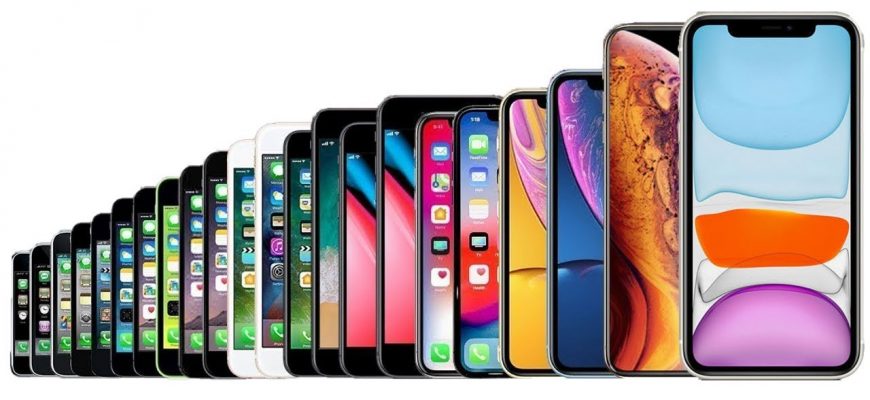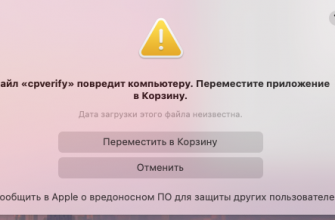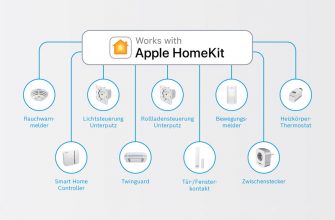Apple iPhone — one of the most popular and sought-after smartphones in the world. Since the first iPhone, introduced in 2007, Apple has been constantly developing and improving its line of phones, offering consumers devices with advanced technology, innovative design and excellent quality. This article provides a detailed review of iPhone models, starting with the iPhone 5 and up to the latest models available at the time of my last update, providing information on their specifications, features and prices.
In this article, we will cover the main aspects of each model, such as the year of release and discontinuation, labeling variations for different countries, a brief description, key features, operating system and updates, as well as prices and configurations. This will help you better understand the differences between the models and make the right choice when buying an iPhone.
- iPhone 5 (A1428, A1429)
- Year of production and Year of discontinuation:
- Labeling options for other countries:
- Brief description of the model:
- Main characteristics:
- Operating system and updates:
- Prices and configurations:
- iPhone 5s (A1453, A1533, A1457, A1530)
- Year of production and Year of discontinuation:
- Labeling options for other countries:
- Brief description of the model:
- Main characteristics:
- Operating system and updates:
- Prices and configurations:
- iPhone 6 and iPhone 6 Plus (A1549, A1586, A1589, A1522, A1524, A1593)
- Year of production and Year of discontinuation:
- Labeling options for other countries:
- Brief description of the model:
- Main characteristics:
- Operating system and updates:
- Prices and configurations:
- iPhone 6s and iPhone 6s Plus (A1633, A1688, A1700, A1634, A1687, A1699)
- Year of production and Year of discontinuation:
- Labeling options for other countries:
- Brief description of the model:
- Main characteristics:
- Operating system and updates:
- Prices and configurations:
- iPhone SE (first generation) (A1662, A1723, A1724)
- Year of production and Year of discontinuation:
- Labeling options for other countries:
- Brief description of the model:
- Main characteristics:
- Operating system and updates:
- Prices and configurations:
- iPhone 7 and iPhone 7 Plus (A1660, A1778, A1779, A1661, A1784, A1785)
- Year of production and Year of discontinuation:
- Labeling options for other countries:
- Brief description of the model:
- Main characteristics:
- Operating system and updates:
- How much does iPhone 7 and 7 plus cost:
- iPhone 8 and iPhone 8 Plus (A1863, A1905, A1906, A1864, A1897, A1898)
- Year of production and Year of discontinuation:
- Labeling options for other countries:
- Brief description of the model:
- Main characteristics:
- Operating system and updates:
- How much does iPhone 8 and 8 PLUS cost:
- iPhone X (A1865, A1901, A1902)
- Year of production and Year of discontinuation:
- Labeling options for other countries:
- Brief description of the model:
- Main characteristics:
- Operating system and updates:
- How much does iPhone X cost:
- iPhone XR (A1984, A2105, A2106, A2108)
- Year of production and Year of discontinuation:
- Labeling options for other countries:
- Brief description of the model:
- Main characteristics:
- Operating system and updates:
- How much does iPhone XR cost:
- iPhone XS and iPhone XS Max (A1920, A2097, A2098, A2100 / A1921, A2101, A2102, A2104)
- Year of production and Year of discontinuation:
- Labeling options for other countries:
- Brief description of the model:
- Main characteristics:
- Operating system and updates:
- How much does iPhone XS cost:
- iPhone 11 (A2111, A2221, A2223)
- Year of production and Year of discontinuation:
- Labeling options for other countries:
- Brief description of the model:
- Main characteristics:
- Additional features:
- Operating system and updates:
- How much does iPhone 11 cost:
- iPhone 11 Pro and iPhone 11 Pro Max (A2160, A2215, A2217 / A2161, A2218, A2220)
- Year of production and Year of discontinuation:
- Labeling options for other countries:
- Brief description of the model:
- Main characteristics:
- Operating system and updates:
- How much does iPhone 11 Pro and iPhone 11 Pro MAX cost:
- iPhone SE 2020 (A2275, A2296, A2298)
- Year of production and Year of discontinuation:
- Labeling options for other countries:
- Brief description of the model:
- Main characteristics:
- Operating system and updates:
- How much does iPhone SE 2020 cost:
iPhone 5 (A1428, A1429)

Year of production and Year of discontinuation:
The iPhone 5 was released in September 2012 and discontinued in September 2013.
Labeling options for other countries:
- A1428: North America
- A1429: International Version, Asia, Europe, Australia
Brief description of the model:
The iPhone 5 was the first Apple smartphone to feature a larger display and a new design. It was a significant upgrade over the previous iPhone 4s, offering improved specs and support for LTE networks.
This model also debuted the Lightning connector, which became the new charging standard for Apple devices. The iPhone 5 also offered improved performance thanks to the new Apple A6 processor and increased RAM.
Main characteristics:
- Display: 4-inch Retina Display
- Processor: Apple A6
- RAM: 1 GB
- Built-in memory: 16/32/64 GB
- Main camera: 8 MP
- Front camera: 1.2 MP
- Battery: 1440 mAh
Operating system and updates:
The iPhone 5 came with iOS 6, which introduced new features like Apple Maps and an improved Siri. The latest available version of the operating system for this model is iOS 10.3.4, released in July 2019.
After the release of iOS 11 in September 2017, the iPhone 5 stopped receiving major operating system updates, but continued to receive bug fixes and security updates until the latest available update, iOS 10.3.4.
Prices and configurations:
The iPhone 5 price at launch ranged from $199 (16GB) to $399 (64GB). Subsequently, as new models were released, the price of the iPhone 5 dropped. On the secondary market today, the price of the iPhone 5 can fluctuate depending on the condition of the device
iPhone 5s (A1453, A1533, A1457, A1530)

Year of production and Year of discontinuation:
The iPhone 5s was introduced in September 2013 and discontinued in September 2016.
Labeling options for other countries:
- A1453: North America (CDMA)
- A1533: North America (GSM)
- A1457: Europe, Asia, Australia
- A1530: Asia, Europe, Australia
Brief description of the model:
The iPhone 5s is the seventh generation of Apple smartphones and the first to introduce Touch ID technology for unlocking the device and authorizing purchases. It was available in three colors: silver, gold, and space gray.
In terms of design, the iPhone 5s is very similar to the previous iPhone 5 model. However, the internal components have been significantly upgraded, including the new Apple A7 processor, which was the first 64-bit processor in a smartphone, and the M7 motion coprocessor.
Main characteristics:
- Display: 4-inch Retina Display
- Processor: Apple A7
- RAM: 1 GB
- Built-in memory: 16/32/64 GB
- Main camera: 8 MP with dual LED flash
- Front camera: 1.2 MP
- Battery: 1560 mAh
- Additional features: Touch ID
Operating system and updates:
The iPhone 5s came with iOS 7, which introduced a new interface design and many new features, such as Control Center and AirDrop. The iPhone 5s supported operating system updates up to iOS 12.5.5, released in September 2021.
Since major update support ended with iOS 13, the iPhone 5s has continued to receive bug fixes and security updates up to the latest available version, iOS 12.5.5.
Prices and configurations:
The price of the iPhone 5s when it was released ranged from $199 (16 GB) to $399 (64 GB). Subsequently, after the appearance of new models, the price of the iPhone 5s decreased. On the secondary market today, the price of the iPhone 5s can fluctuate depending on the condition of the device and the amount of built-in memory.
iPhone 6 and iPhone 6 Plus (A1549, A1586, A1589, A1522, A1524, A1593)

Year of production and Year of discontinuation:
iPhone 6 and iPhone 6 Plus were introduced in September 2014 and discontinued in September 2018.
Labeling options for other countries:
- A1549: North America (iPhone 6 GSM/CDMA)
- A1586: International Version, Asia, Europe, Australia (iPhone 6)
- A1589: China (iPhone 6)
- A1522: North America (iPhone 6 Plus GSM/CDMA)
- A1524: International Version, Asia, Europe, Australia (iPhone 6 Plus)
- A1593: China (iPhone 6 Plus)
Brief description of the model:
The iPhone 6 and iPhone 6 Plus were the first Apple smartphones to feature larger displays, measuring 4.7 inches and 5.5 inches respectively. These models offered a completely new design with rounded edges and a thinner body. They also featured improved cameras and the new Apple A8 processor.
The iPhone 6 Plus also offered optical image stabilization for the main camera, and both models received support for Apple Pay thanks to the built-in NFC chip.
Main characteristics:
- Display: 4.7-inch (iPhone 6) and 5.5-inch (iPhone 6 Plus) Retina Display
- Processor: Apple A8
- RAM: 1 GB
- Built-in memory: 16/64/128 GB
- Main camera: 8 MP with optical image stabilization (iPhone 6 Plus only)
- Front camera: 1.2 MP
- Battery: 1810 mAh (iPhone 6), 2915 mAh (iPhone 6 Plus)
- Additional functions: Apple Pay, NFC
Operating system and updates:
The iPhone 6 and iPhone 6 Plus came with iOS 8, which introduced new features like Handoff, Continuity, and improved integration with other Apple devices. Both models supported operating system updates to iOS 12.5.5, released in September 2021.
Since major update support ended with iOS 13, iPhone 6 and iPhone 6 Plus have continued to receive bug fixes and security updates up to the latest available version, iOS 12.5.5.
Prices and configurations:
The iPhone 6 was priced from $$199 (16GB) to $$399 (128GB) when it was released, and the iPhone 6 Plus was priced from $$299 (16GB) to $$499 (128GB). Subsequently, after the release of new models, the prices of the iPhone 6 and iPhone 6 Plus decreased. On the secondary market today, the price of the iPhone 6 and iPhone 6 Plus can fluctuate depending on the condition of the device and the amount of built-in memory.
iPhone 6s and iPhone 6s Plus (A1633, A1688, A1700, A1634, A1687, A1699)

Year of production and Year of discontinuation:
iPhone 6s and iPhone 6s Plus were introduced in September 2015 and discontinued in September 2018.
Labeling options for other countries:
- A1633: North America (iPhone 6s GSM/CDMA)
- A1688: International Version, Asia, Europe, Australia (iPhone 6s)
- A1700: China (iPhone 6s)
- A1634: North America (iPhone 6s Plus GSM/CDMA)
- A1687: International Version, Asia, Europe, Australia (iPhone 6s Plus)
- A1699: China (iPhone 6s Plus)
Brief description of the model:
The iPhone 6s and iPhone 6s Plus introduced the new 3D Touch technology, which can detect different levels of pressure on the screen and offer contextual menus accordingly. These models also received an improved aluminum case, a new Apple A9 processor, 2 GB of RAM, and improved cameras. The iPhone 6s Plus also continued to support optical image stabilization for the main camera.
Main characteristics:
- Display: 4.7-inch (iPhone 6s) and 5.5-inch (iPhone 6s Plus) Retina Display with 3D Touch
- Processor: Apple A9
- RAM: 2 GB
- Built-in memory: 16/64/128 GB
- Main camera: 12 MP with optical image stabilization (iPhone 6s Plus only)
- Front camera: 5 MP
- Battery: 1715 mAh (iPhone 6s), 2750 mAh (iPhone 6s Plus)
- Additional features: 3D Touch, Apple Pay, NFC
Operating system and updates:
The iPhone 6s and iPhone 6s Plus shipped with iOS 9, which brought performance improvements, power management, and new features like Apple News and updated multitasking for iPad. Both models are supported by operating system updates to iOS 15, released in September 2021.
Since the release of iOS 15, iPhone 6s and iPhone 6s Plus continue to receive bug fixes and security updates, although some new features may not be available on these devices due to hardware limitations.
Prices and configurations:
The iPhone 6s was priced from $$649 (16GB) to $$849 (128GB) when it was released, and the iPhone 6s Plus was priced from $$749 (16GB) to $$949 (128GB). Subsequently, after new models were released, the prices for the iPhone 6s and iPhone 6s Plus dropped. Today, the price of the iPhone 6s and iPhone 6s Plus on the secondary market may fluctuate depending on the condition of the device and the amount of built-in memory.
iPhone SE (first generation) (A1662, A1723, A1724)

Year of production and Year of discontinuation:
The first generation iPhone SE was introduced in March 2016 and discontinued in September 2018.
Labeling options for other countries:
- A1662: North America (iPhone SE GSM/CDMA)
- A1723: International Version, Asia, Europe, Australia (iPhone SE)
- A1724: China (iPhone SE)
Brief description of the model:
The first-generation iPhone SE was designed as a more affordable and compact version of Apple's 4-inch smartphone, combining the classic iPhone 5s design with the improved Apple A9 processor and cameras from the iPhone 6s. This makes it a powerful and productive device in a smaller form factor.
Main characteristics:
- Display: 4-inch Retina Display
- Processor: Apple A9
- RAM: 2 GB
- Built-in memory: 16/64 GB
- Main camera: 12 MP
- Front camera: 1.2 MP
- Battery: 1624 mAh
- Additional functions: Apple Pay, NFC
Operating system and updates:
The first-generation iPhone SE shipped with iOS 9.3 and supported operating system updates up to iOS 15, released in September 2021.
Since the release of iOS 15, the first-generation iPhone SE continues to receive bug fixes and security updates, although some new features may not be available on this device due to hardware limitations.
Prices and configurations:
The first generation iPhone SE was priced at $399 (16GB) and $499 (64GB) when it was released. Subsequently, after new models were released, the price of the first generation iPhone SE was reduced. Today, the price of the first generation iPhone SE on the secondary market may fluctuate depending on the condition of the device and the amount of built-in memory.
iPhone 7 and iPhone 7 Plus (A1660, A1778, A1779, A1661, A1784, A1785)

Year of production and Year of discontinuation:
The iPhone 7 and iPhone 7 Plus were introduced in September 2016 and discontinued in September 2019.
Labeling options for other countries:
- A1660: North America (iPhone 7 GSM/CDMA)
- A1778: International Version, Asia, Europe, Australia (iPhone 7)
- A1779: Japan (iPhone 7)
- A1661: North America (iPhone 7 Plus GSM/CDMA)
- A1784: International Version, Asia, Europe, Australia (iPhone 7 Plus)
- A1785: Japan (iPhone 7 Plus)
Brief description of the model:
The iPhone 7 and iPhone 7 Plus featured a redesigned design with improved water resistance, as well as the new Apple A10 Fusion processor. They were the first iPhone models to not have a 3.5mm audio jack, instead offering the use of Bluetooth headsets or a Lightning-to-3.5mm adapter. The iPhone 7 Plus also featured a dual rear camera with optical zoom and portrait mode.
Main characteristics:
- Display: 4.7-inch (iPhone 7) and 5.5-inch (iPhone 7 Plus) Retina Display
- Processor: Apple A10 Fusion
- RAM: 2 GB (iPhone 7), 3 GB (iPhone 7 Plus)
- Built-in memory: 32/128/256 GB
- Main camera: 12 MP (single for iPhone 7, dual for iPhone 7 Plus with optical zoom and portrait mode)
- Front camera: 7 MP
- Battery: 1960 mAh (iPhone 7), 2900 mAh (iPhone 7 Plus)
- Additional features: Apple Pay, NFC, waterproof (IP67)
Operating system and updates:
The iPhone 7 and iPhone 7 Plus shipped with iOS 10, which introduced improved integration with smart home devices, redesigned Messages, and new capabilities for Siri.
They support operating system updates up to iOS 15, released in September 2021. Since the release of iOS 15, iPhone 7 and iPhone 7 Plus continue to receive bug fixes and security updates, although some new features may not be available on these devices due to hardware limitations.
What is the price iPhone 7 and 7 plus:
The iPhone 7 was priced from $$649 (32GB) to $$849 (256GB) when it was released, and the iPhone 7 Plus was priced from $$769 (32GB) to $$969 (256GB). Subsequently, after new models were released, the prices of the iPhone 7 and iPhone 7 Plus dropped. Today, the price of the iPhone 7 and iPhone 7 Plus on the secondary market can fluctuate depending on the condition of the device and the amount of built-in memory.
iPhone 8 and iPhone 8 Plus (A1863, A1905, A1906, A1864, A1897, A1898)

Year of production and Year of discontinuation:
The iPhone 8 and iPhone 8 Plus were introduced in September 2017 and discontinued in April 2020.
Labeling options for other countries:
- A1863: North America (iPhone 8 GSM/CDMA)
- A1905: International Version, Asia, Europe, Australia (iPhone 8)
- A1906: Japan (iPhone 8)
- A1864: North America (iPhone 8 Plus GSM/CDMA)
- A1897: International Version, Asia, Europe, Australia (iPhone 8 Plus)
- A1898: Japan (iPhone 8 Plus)
Brief description of the model:
The iPhone 8 and iPhone 8 Plus feature a new design with a glass back for wireless charging, an improved Apple A11 Bionic chip, and True Tone support for more accurate colors. The iPhone 8 Plus also features improved Portrait mode and Portrait Lighting.
Main characteristics:
- Display: 4.7-inch (iPhone 8) and 5.5-inch (iPhone 8 Plus) Retina Display with True Tone
- Processor: Apple A11 Bionic
- RAM: 2 GB (iPhone 8), 3 GB (iPhone 8 Plus)
- Built-in memory: 64/256 GB
- Main camera: 12 MP (single for iPhone 8, dual for iPhone 8 Plus with optical zoom, Portrait mode and Portrait Lighting)
- Front camera: 7 MP
- Battery: 1821 mAh (iPhone 8), 2691 mAh (iPhone 8 Plus)
- Additional features: Apple Pay, NFC, waterproof (IP67), wireless charging
Operating system and updates:
The iPhone 8 and iPhone 8 Plus shipped with iOS 11, which introduced a new control panel design, an improved App Store, an updated Do Not Disturb feature, and additional camera and photo capabilities. These models support operating system updates to iOS 15 and continue to receive bug fixes and security updates. In the future, some new features may not be available on these devices due to hardware limitations.
What is the price iPhone 8 and 8 PLUS:
The iPhone 8 was priced from $$699 (64GB) to $$849 (256GB) when it was released, and the iPhone 8 Plus was priced from $$799 (64GB) to $$949 (256GB). Subsequently, after the release of new models, the prices of the iPhone 8 and iPhone 8 Plus decreased. On the secondary market today, the price of the iPhone 8 and iPhone 8 Plus can fluctuate depending on the condition of the device and the amount of built-in memory.
iPhone X (A1865, A1901, A1902)

Year of production and Year of discontinuation:
The iPhone X was introduced in September 2017 and discontinued in September 2018.
Labeling options for other countries:
- A1865: North America (GSM/CDMA)
- A1901: International Version, Asia, Europe, Australia (GSM)
- A1902: Japan (GSM)
Brief description of the model:
The iPhone X was the first iPhone to feature a new design, featuring a nearly all-screen display, a notch at the top of the screen, and no Home button. Instead of Touch ID, the iPhone X introduced Face ID, an innovative facial recognition unlocking system. It also featured an improved A11 Bionic processor and wireless charging support.
Main characteristics:
- Display: 5.8-inch Super Retina OLED with True Tone and HDR support
- Processor: Apple A11 Bionic
- RAM: 3 GB
- Built-in memory: 64/256 GB
- Main camera: 12 MP dual with optical zoom, portrait mode and portrait lighting
- Front camera: 7 MP TrueDepth with Face ID and portrait mode
- Battery: 2716 mAh
- Additional features: Apple Pay, NFC, waterproof (IP67), wireless charging
Operating system and updates:
The iPhone X shipped with iOS 11 and supports operating system updates up to iOS 15. This model continues to receive bug fixes and security updates, although some new features may not be available on this device due to hardware limitations.
What is the price iPhone X:
The iPhone X price at launch ranged from $999 (64GB) to $1149 (256GB). Subsequently, as new models were released, the iPhone X prices dropped. On the secondary market today, the iPhone X price may fluctuate depending on the condition of the device and the amount of built-in memory.
iPhone XR (A1984, A2105, A2106, A2108)

Year of production and Year of discontinuation:
The iPhone XR was introduced in September 2018 and discontinued in September 2020.
Labeling options for other countries:
- A1984: North America (GSM/CDMA)
- A2105: International Version, Europe, Australia (GSM)
- A2106: Japan (GSM)
- A2108: China (GSM/CDMA)
Brief description of the model:
The iPhone XR was introduced as a more affordable option in the 2018 iPhone lineup. This model retains the design of the iPhone X, including the notch at the top of the screen and the lack of a Home button, but it has a Liquid Retina display based on LCD technology instead of OLED. The iPhone XR also features the Apple A12 Bionic processor and supports Face ID.
Main characteristics:
- Display: 6.1-inch Liquid Retina LCD with True Tone support
- Processor: Apple A12 Bionic
- RAM: 3 GB
- Built-in memory: 64/128/256 GB
- Main camera: 12 MP single with portrait mode and portrait lighting
- Front camera: 7 MP TrueDepth with Face ID and portrait mode
- Battery: 2942 mAh
- Additional features: Apple Pay, NFC, waterproof (IP67), wireless charging
Operating system and updates:
The iPhone XR shipped with iOS 12 and supports operating system updates up to iOS 15. This model continues to receive bug fixes and security updates, although some new features may not be available on this device due to hardware limitations.
How much does iPhone XR cost:
The iPhone XR price at launch ranged from $749 (64GB) to $899 (256GB). Subsequently, after the release of new models, the prices of the iPhone XR decreased. On the secondary market today, the price of the iPhone XR can fluctuate depending on the condition of the device and the amount of built-in memory.
iPhone XS and iPhone XS Max (A1920, A2097, A2098, A2100 / A1921, A2101, A2102, A2104)

Year of production and Year of discontinuation:
The iPhone XS and iPhone XS Max were introduced in September 2018 and discontinued in September 2019.
Labeling options for other countries:
iPhone XS:
- A1920: North America (GSM/CDMA)
- A2097: International Version, Europe, Australia (GSM)
- A2098: Japan (GSM)
- A2100: China (GSM/CDMA)
iPhone XS Max:
- A1921: North America (GSM/CDMA)
- A2101: International Version, Europe, Australia (GSM)
- A2102: Japan (GSM)
- A2104: China (GSM/CDMA)
Brief description of the model:
The iPhone XS and iPhone XS Max continued the iPhone X design, but received an improved Apple A12 Bionic processor, more storage options (up to 512 GB), and improved water resistance (IP68). The iPhone XS Max was the first Apple smartphone with a 6.5-inch screen.
Main characteristics:
- Display: 5.8-inch (iPhone XS) and 6.5-inch (iPhone XS Max) Super Retina OLED with True Tone and HDR
- Processor: Apple A12 Bionic
- RAM: 4 GB
- Built-in memory: 64/256/512 GB
- Main camera: 12 MP dual with optical zoom, portrait mode and portrait lighting
- Front camera: 7 MP TrueDepth with Face ID and portrait mode
- Battery: 2658 mAh (iPhone XS), 3174 mAh (iPhone XS Max)
- Additional features: Apple Pay, NFC, water resistance (IP68), wireless charging
Operating system and updates:
iPhone XS and iPhone XS Max shipped with iOS 12 and support operating system updates up to iOS 15. These models continue to receive bug fixes and security updates, although some new features may not be available on these devices due to hardware limitations.
How much does iPhone XS cost:
The iPhone XS was priced from $1,000 (64GB) to $1,000 (512GB) when it was released, and the iPhone XS Max was priced from $1,000 (64GB) to $1,000 (512GB). Subsequently, after the release of new models, the prices of the iPhone XS and XS Max decreased. On the secondary market today, the price of the iPhone XS and XS Max may fluctuate depending on the condition of the device and the amount of built-in memory.
iPhone 11 (A2111, A2221, A2223)

Year of production and Year of discontinuation:
The iPhone 11 was introduced in September 2019. It has not been officially discontinued as of my last update in September 2021.
Labeling options for other countries:
- A2111: North America (GSM/CDMA)
- A2221: International Version, Europe, Australia (GSM)
- A2223: China (GSM/CDMA)
Brief description of the model:
The iPhone 11 was the successor to the iPhone XR, with improved specs like the Apple A13 Bionic processor, dual rear cameras with an ultra-wide lens, and improved battery life. It retained the Liquid Retina LCD display and Face ID support.
Main characteristics:
- Display: 6.1-inch Liquid Retina LCD with True Tone support
- Processor: Apple A13 Bionic
- RAM: 4 GB
- Built-in memory: 64/128/256 GB
- Main camera: 12 MP dual (wide and ultra-wide) with night mode and portrait lighting
- Front camera: 12 MP TrueDepth with Face ID and portrait mode
- Battery: 3110 mAh
Additional features:
Apple Pay, NFC, waterproof (IP68), wireless charging
Operating system and updates:
The iPhone 11 shipped with iOS 13 and supports operating system updates up to iOS 16. This model continues to receive bug fixes and security updates, although some new features may not be available on this device due to hardware limitations.
How much does iPhone 11 cost:
The iPhone 11 price at launch ranged from $699 (64GB) to $849 (256GB). Subsequently, after the release of new models, the prices for the iPhone 11 decreased. On the secondary market today, the price of the iPhone 11 can fluctuate depending on the condition of the device and the amount of built-in memory.
iPhone 11 Pro and iPhone 11 Pro Max (A2160, A2215, A2217 / A2161, A2218, A2220)

Year of production and Year of discontinuation:
The iPhone 11 Pro and iPhone 11 Pro Max were introduced in September 2019 and discontinued in October 2020.
Labeling options for other countries:
iPhone 11 Pro:
- A2160: North America (GSM/CDMA)
- A2215: International Version, Europe, Australia (GSM)
- A2217: China (GSM/CDMA)
iPhone 11 Pro Max:
- A2161: North America (GSM/CDMA)
- A2218: International Version, Europe, Australia (GSM)
- A2220: China (GSM/CDMA)
Brief description of the model:
The iPhone 11 Pro and iPhone 11 Pro Max were the successors to the iPhone XS series with improved specs like the Apple A13 Bionic processor, a triple rear camera with an ultra-wide lens, improved battery life, and 18W fast charging included.
Main characteristics:
- Display: 5.8-inch (iPhone 11 Pro) and 6.5-inch (iPhone 11 Pro Max) Super Retina XDR OLED with True Tone and HDR
- Processor: Apple A13 Bionic
- RAM: 4 GB
- Built-in memory: 64/256/512 GB
- Main camera: 12 MP triple (wide, ultra-wide and telephoto) with optical zoom, night mode and portrait lighting
- Front camera: 12 MP TrueDepth with Face ID and portrait mode
- Battery: 3046 mAh (iPhone 11 Pro), 3969 mAh (iPhone 11 Pro Max)
- Additional features: Apple Pay, NFC, waterproof (IP68), wireless charging, fast charging 18W
Operating system and updates:
The iPhone 11 Pro and iPhone 11 Pro Max shipped with iOS 13 and support operating system updates up to iOS 15. These models continue to receive bug fixes and security updates, although some new features may not be available on these devices due to hardware limitations.
How much does the iPhone 11 Pro cost and iPhone 11 Pro MAX:
The iPhone 11 Pro was priced from $$999 (64GB) to $$1349 (512GB) when it was released, and the iPhone 11 Pro Max was priced from $$1099 (64GB) to $$1449 (512GB). Subsequently, after the release of new models, the prices of the iPhone 11 Pro and Pro Max decreased. On the secondary market today, the price of the iPhone 11 Pro and 11 Pro Max may fluctuate depending on the condition of the device and the amount of built-in memory.
iPhone SE 2020 (A2275, A2296, A2298)

Year of production and Year of discontinuation:
The iPhone SE (2nd generation) was introduced in April 2020 and was still on sale as of my last update in September 2021.
Labeling options for other countries:
- A2275: North America, Europe, Australia (GSM/CDMA)
- A2296: Europe (GSM)
- A2298: China (GSM/CDMA)
Brief description of the model:
iPhone SE (2nd generation) is the successor to the original iPhone SE, combining modern technology with an affordable price. It features the Apple A13 Bionic processor, an improved camera with portrait mode support, and a compact 4.7-inch display.
Main characteristics:
- Display: 4.7-inch Retina HD with True Tone
- Processor: Apple A13 Bionic
- RAM: 3 GB
- Built-in memory: 64/128/256 GB
- Main camera: 12 MP with optical image stabilization, portrait mode and portrait lighting
- Front camera: 7 MP with portrait mode support
- Battery: 1821 mAh
- Additional functions: Apple Pay, NFC, Touch ID
Operating system and updates:
iPhone SE (2nd generation) shipped with iOS 13 and supports operating system updates up to iOS 15. This model continues to receive bug fixes and security updates, although some new features may not be available on this device due to hardware limitations.
How much does the iPhone SE cost? 2020:
The iPhone SE (2nd generation) was priced from $$399 (64GB) to $$549 (256GB) when it was released. The price of the iPhone SE (2nd generation) may decrease after new iPhone models are released. On the secondary market today, the price of the iPhone SE (2nd generation) may fluctuate depending on the condition of the device and the amount of built-in memory.








